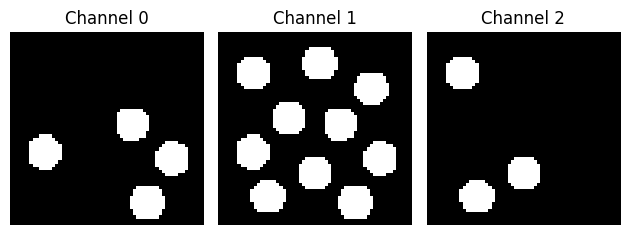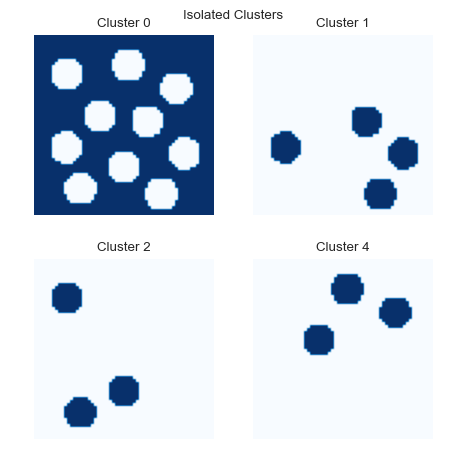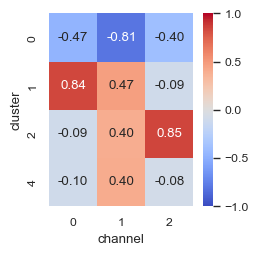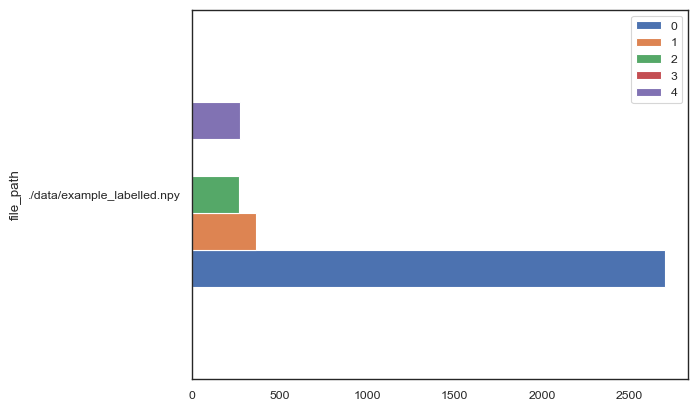Pixel-based clustering¶
In this tutorial we will focus on pixel-based clustering. This tutorial assumes, that you have already registered and pre-processed your data.
[1]:
import numpy as np
import seaborn as sns
from skimage.transform import downscale_local_mean
import spatiomic as so
[2]:
# read the example data
img_data = so.data.read().read_tiff("./data/example.tif")
img_data = (downscale_local_mean(img_data, (4, 4, 1)) + 1 > 0).astype(float) * 255
Let’s take a look at the data:
[3]:
import matplotlib.pyplot as plt
fig, ax = plt.subplots(1, 3)
for i in range(3):
ax[i].imshow(img_data[:, :, i], cmap="gray")
ax[i].set_title("Channel {}".format(i))
ax[i].axis("off")
plt.tight_layout()

SOM training¶
First, we create our self-organizing map. The node count should scale with the size of your dataset and the complexity of your data. It is advisable to use the euclidean, cosine or correlation (Pearson correlation) distance metric for biological data.
[4]:
som = so.dimension.som(
node_count=(30, 30),
dimension_count=img_data.shape[-1],
distance_metric="euclidean",
use_gpu=False,
seed=42,
)
WARNING: CuPy could not be imported
WARNING: CuPy could not be imported
WARNING: CuPy could not be imported
Next, we train our SOM on the data. Depending on the size of the data and the node count, this may take a while. To speed training up, consider training on a random subsample of your data. This can be achieved via pp.data.subsample(data, method="fraction", fraction=0.1) or pp.data.subsample(data, method="count", count=10^9).
[5]:
img_data_subsample = so.data.subsample().fit_transform(img_data, method="fraction", fraction=0.5, seed=42)
[6]:
som.fit(img_data_subsample, iteration_count=100)
53%|█████▎ | 53/100 [00:00<00:00, 134.43it/s]/Users/au734063/Documents/code/spatiomic/.venv/lib/python3.12/site-packages/xpysom/xpysom.py:413: RuntimeWarning: divide by zero encountered in divide
self._numerator_gpu / self._denominator_gpu,
/Users/au734063/Documents/code/spatiomic/.venv/lib/python3.12/site-packages/xpysom/xpysom.py:413: RuntimeWarning: invalid value encountered in divide
self._numerator_gpu / self._denominator_gpu,
100%|██████████| 100/100 [00:00<00:00, 117.93it/s]
Graph clustering¶
After our self-organising map finishes training, we can use its nodes that now represent the topography of our dataset to create a kNN graph. Finally, we perform Leiden graph clustering.
[7]:
knn_graph = so.neighbor.knn_graph().create(som, neighbor_count=100, distance_metric="euclidean", use_gpu=False)
clusters, modularity = so.cluster.leiden().predict(
knn_graph, resolution=0.5, seed=42, use_gpu=False, iteration_count=10
)
Plotting & evaluation¶
Now that we have identified clusters for each SOM node, we can use our SOM class to assign the cluster label of the closest SOM node to each pixel in the original data.
[8]:
labelled_data = som.label(img_data, clusters, save_path="./data/example_labelled.npy")
We can use the plot submodule to visualize the data:
[9]:
colormap = so.plot.colormap(color_count=np.array(clusters).max() + 1, flavor="glasbey")
fig = so.plot.cluster_image(
labelled_data,
colormap=colormap,
)
/var/folders/vg/vt1jjh256dn1g4sd6pknwxbs_qmnws/T/ipykernel_71212/2329922638.py:1: UserWarning: The glasbey color palette is part of colorcet and distributed under the Creative Commons Attribution 4.0 International Public License (CC-BY).
colormap = so.plot.colormap(color_count=np.array(clusters).max() + 1, flavor="glasbey")

We can also plot the locations of individual clusters:
[10]:
fig = so.plot.cluster_location(labelled_data)
fig.set_size_inches(5, 5)
fig.tight_layout(pad=2)

We can further evaluate how distributed the clusters are by calculating Moran’s I.
[11]:
df_morans_i = so.spatial.autocorrelation().predict(labelled_data, method="moran", permutation_count=500)
Calculating spatial autocorrelation for each channel/cluster: 100%|██████████| 4/4 [00:00<00:00, 22.80it/s]
[12]:
df_morans_i
[12]:
| cluster | morans_i | morans_i_expected | p_value | z_score | |
|---|---|---|---|---|---|
| 0 | 0 | 0.810741 | -0.000278 | 0.001996 | 95.179651 |
| 1 | 1 | 0.841830 | -0.000278 | 0.001996 | 102.301234 |
| 2 | 2 | 0.846760 | -0.000278 | 0.001996 | 96.882256 |
| 3 | 4 | 0.846887 | -0.000278 | 0.001996 | 102.385384 |
To evaluate the correlation of the clusters with the channels in the original image, we can use the bivariate version of Moran’s I.
[13]:
df_bv_morans_i = so.spatial.bivariate_correlation().predict(
data=labelled_data,
channel_image=img_data,
method="moran",
)
/Users/au734063/Documents/code/spatiomic/.venv/lib/python3.12/site-packages/spatiomic/spatial/_bivariate_correlation.py:126: FutureWarning: The behavior of DataFrame concatenation with empty or all-NA entries is deprecated. In a future version, this will no longer exclude empty or all-NA columns when determining the result dtypes. To retain the old behavior, exclude the relevant entries before the concat operation.
df_clusters = pd.concat([df_clusters, df_correlation], ignore_index=True)
An easy way to look at this data is by using the heatmap functionality from seaborn.
[14]:
fig, ax = plt.subplots(dpi=100, figsize=(2.5, 2.5))
sns.heatmap(
df_bv_morans_i.pivot(index="cluster", columns="channel", values="morans_i"),
cmap="coolwarm",
vmin=-1,
vmax=1,
annot=True,
fmt=".2f",
square=True,
ax=ax,
)
[14]:
<Axes: xlabel='channel', ylabel='cluster'>

Statistics¶
We can also get the counts for each cluster in our image.
[15]:
df_cluster_abundances = so.tool.count_clusters(
file_paths=["./data/example_labelled.npy"],
cluster_count=labelled_data.max() + 1,
)
[16]:
df_cluster_abundances.plot.barh()
[16]:
<Axes: ylabel='file_path'>

[ ]: